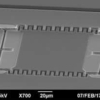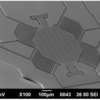Geometrical compensation of (100) single-crystal silicon mode-matched vibratory ring gyroscope
MEMS gyroscopes for measuring rate or angle of rotation can be used to provide heading information for inertial navigation purposes or in other areas, such as automotive applications for ride stabilization and rollover detection.
When the resonant frequencies of drive and sense modes are matched, the mechanical output of a MEMS vibratory ring gyroscope (VRG) is maximum, so the high performance is accessible. In this research, we proposed a geometrical compensation design method to compensate the anisotropic in-plane Young’s modulus in order to realize the mode-matching in (100) single crystal silicon (SCS) VRG.
[Applications]
- Navigation
- Inertia measurement unit

[Publication]
- Yunyi Shu, Yoshikazu Hirai, Toshiyuki Tsuchiya, Osamu Tabata
Geometrical compensation of (100) single-crystal silicon mode-matched vibratory ring gyroscope
The 5th IEEE International Symposium on Inertial Sensors & Systems (INERTIAL 2018), Lake Como, Italy, March 26-29, 2018, P1-15.









